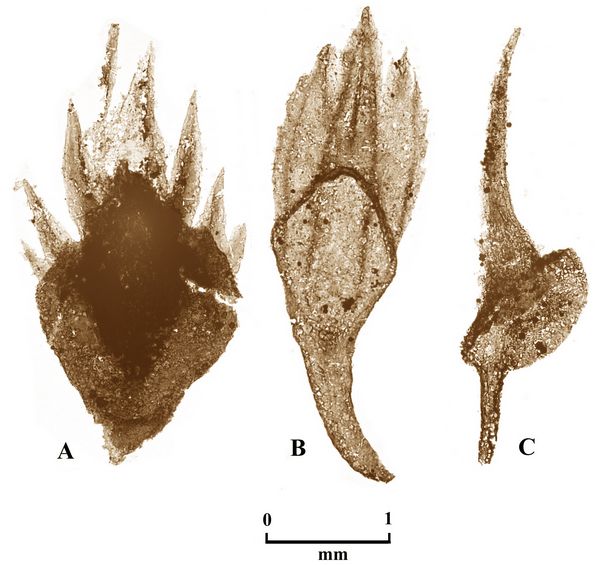Athena Review Image Archive ™
Thelodont scales

Thelodont scales. A) Paralogonia sp.; B) Shielia taiti; c) Lanarkia horrida (after Turner 1991)
Thelodonts were jawless fish who lived in shallow water and were covered with a flexible body armor made up of many tooth-like or spiny scales called denticles, such as represented here on Paralogonia, Shielia, and Lanarkia. Thelodonts first appeared during the Late Ordovician period (450 mya), and lived until the Frasnian–Famennian extinction at the end of the Devonian period (about 359 mya).
The name Thelodont comes from thelo- "nipple," and -dont "tooth" or "scale." They are in the phylum Chordata, the subphylum Vertebrata, and the class Thelodonti. The four orders of Theolodonts include Theleodontina, Loganiida, Katoporida, and Furcacaudiformes, comprising a total of 67 species (Turner 1991).
Thelodont scales were first described by Louis Agassiz in the late 1830s. These scales were so abundant that they are the most commonly found type of vertebrate fossil of their time frame. Often the scale has linear ridges and and spikes along its length, showing sometimes complex patterns, which together with the form of the scale may be species-diagnostic. The teardrop-shaped thelodont scales have a pulp cavity and are mounted on a base, often with a small rootlet that attached the scale to the fish. These non-overlapping scales were aligned to point backwards along the fish, in a streamlined direction.
Thelodonts have a flattened head with lateral paired fins, small eyes, and eight ventrally placed gill slits. They have one dorsal fin, one anal fin, and a caudal fin, which aided their evasive swimming from their main predators, giant sea scorpions (eurypterids) up to two meters long such as Pterygotus. Thelodonts survived longer in the southern megacontinent Gondwana than in the northern Laurasia, where they disappeared after the early Middle Devonian.
Thelodont fossil
specimens described in 1993 were found with unexpected evidence of
a stomach. Previously it had been thought that stomachs evolved after
jaws.
References:
Turner, S. 1991. Monophyly and interrelationships of the Thelodonti. In Early vertebrates and related problems of evolutionary biology (ed. M. M. Chang, Y. H. Liu, and G. R. Zhang), pp. 87-111.
Copyright © 1996-2020 Rust Family Foundation (All Rights Reserved).